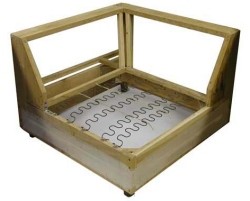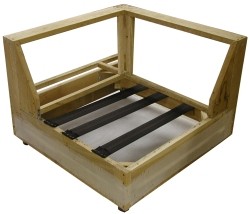So your old sofa is looking pretty sad after all living through all those 49ner games, birthday parties, kids using it as a trampoline, and afternoon naps? But where do you begin and what should it cost? How do you find one that will fit in your budget, be good quality and get here before the Holidays? Here’s some information to help you on your quest.
Quality First
When making big purchasing decisions for your home, consider their life in your life. For the big things that most people don’t change on a whim like sofas, kitchen appliances, and window coverings, buy the best quality you can afford now, consider how long you will own it, and then divide the cost over that timeframe to judge if you can afford it. For a sofa, it should last and look great for a minimum of 10 years. If you buy the best quality, it will last for 20 years, but you’ll probably be tired of the fabric after 10, so you can decide then to either replace it or recover it.
What’s Inside? A quality sofa has:
Quality First
When making big purchasing decisions for your home, consider their life in your life. For the big things that most people don’t change on a whim like sofas, kitchen appliances, and window coverings, buy the best quality you can afford now, consider how long you will own it, and then divide the cost over that timeframe to judge if you can afford it. For a sofa, it should last and look great for a minimum of 10 years. If you buy the best quality, it will last for 20 years, but you’ll probably be tired of the fabric after 10, so you can decide then to either replace it or recover it.
What’s Inside? A quality sofa has:
mortise and tenon frame joints,
 corner blocks with both staples and screws.
corner blocks with both staples and screws. 
Are you eco-conscious? Look for companies that have switched from hardwood to cross-laminated veneers to reduce dependence on declining sources of old growth timber. These are actually more durable than hardwood due to the multiple layers of glued wood. Caution here, be sure the glues don’t contain toxic formaldehyde.
Seating Suspension System. The suspension system which hides under the cushions makes a big difference in how the sofa feels when you sit on it, just like the ride in a car. Think about it. The more support that is provided, the more comfortable the seating will be…and the longer it will last.
There are three types of suspension system under the cushions and fabric decking that you see when you go shopping. The most important question to ask when buying a sofa which will have a big impact on the cost is what type of suspension is in the sofa?
Eight-way hand tied is the time-honored method of building lasting furniture, and provides the most long-lasting supportive construction. This construction can only be done by hand, so it takes time and labor. In this construction technique every individual coil in the spring seat system is joined by twine that is hand-tied with 8 knots.
Seating Suspension System. The suspension system which hides under the cushions makes a big difference in how the sofa feels when you sit on it, just like the ride in a car. Think about it. The more support that is provided, the more comfortable the seating will be…and the longer it will last.
There are three types of suspension system under the cushions and fabric decking that you see when you go shopping. The most important question to ask when buying a sofa which will have a big impact on the cost is what type of suspension is in the sofa?
Eight-way hand tied is the time-honored method of building lasting furniture, and provides the most long-lasting supportive construction. This construction can only be done by hand, so it takes time and labor. In this construction technique every individual coil in the spring seat system is joined by twine that is hand-tied with 8 knots.
 Some manufacturers claim that steel sinuous wire spring systems are equal, but look at the difference in construction, and then you decide.
Some manufacturers claim that steel sinuous wire spring systems are equal, but look at the difference in construction, and then you decide. 
For sure, a fabric webbed seating system is guaranteed to fail…don’t even consider this unless you want to create some future land fill.


Before you buy, ASK, and if the salesperson does not know, move on to the next store.
The right seat cushion for you depends on what type of “sit” you want! (Photos examples courtesy of Vanguard Furniture)
“Soft and Cushy” Standard cushions usually feature a polyurethane foam core wrapped in polyester fiberfill and a cloth cover. The industry “standard” is a 2.0 support factor, but look for a 2.5 factor or higher if you can find it for additional longevity. Anything less than 2.0 won’t last more than 5 years with active family wear and tear.

The right seat cushion for you depends on what type of “sit” you want! (Photos examples courtesy of Vanguard Furniture)
“Soft and Cushy” Standard cushions usually feature a polyurethane foam core wrapped in polyester fiberfill and a cloth cover. The industry “standard” is a 2.0 support factor, but look for a 2.5 factor or higher if you can find it for additional longevity. Anything less than 2.0 won’t last more than 5 years with active family wear and tear.

“Firm but Cushy” Extra-firm cushions are preferred by older customers who may need a firm seat to make it easier to get up and out of the seat. This is accomplished by using higher compression foam and a tighter wrap of the polyester and muslin cover or adding an extra crown of foam in the center of the cushion.


“Solid and Comfortable with Resilience” Spring-Down cushions offer the best resilience and pliability. The center of the cushion contains a “Marshall Spring unit”, a series of individually wrapped springs each sewn in muslin bags. This set of springs is then surrounded by a foam core, then a wrap containing a mixture of polyester fiber-fill and down, and finally a down-proof cover. This construction is usually the most expensive and will last the longest without front breakdown of the cushion. It is a firm sit that may not be the most comfortable to everyone.


“Shabby Chic – Sometimes looks slept-on!” Ultra-Down cushions. These cushions are usually found in very high quality furniture. The center of the cushion is a foam core, surrounded by a generous combination of polyester fiber, duck down and feather down encased in its own zippered case. The down is quite thick so over time it will flatten out. The case has a zipper so you can remove it from the cushion and toss it in the dryer to “fluff” it up. If you’re a neat freak, always running around “karate chopping” your throw pillows, this is probably not the fill for you.
 “Eco-Friendly” Cushion – Look for cushions that combine a soy-based foam core with a mixed down and feather fill around the center cushion, and covered in a down-proof cotton cover.
“Eco-Friendly” Cushion – Look for cushions that combine a soy-based foam core with a mixed down and feather fill around the center cushion, and covered in a down-proof cotton cover.
The right Back Cushion for you. How much back support do you need?
Standard back cushions are usually constructed with channels of polyester fiberfill to keep the fill from slipping around with use. This material stays in place inside the channels and provides a medium level of support.
Standard back cushions are usually constructed with channels of polyester fiberfill to keep the fill from slipping around with use. This material stays in place inside the channels and provides a medium level of support.

Ultra-Down (or Ultra-Plush) back cushions are a good match for the Ultra-down seat cushions, but will look the most “sat-in".
Tight-back Cushion
 This is a sofa without loose back cushions. The frame is padded with polyurethane and a layer of fiber or down fill and attached for the frame. This is a very neat and contemporary look. It’s a great choice for a guest bedroom sofa-bed where it’s always a question where to throw all the cushions to open up the bed!
This is a sofa without loose back cushions. The frame is padded with polyurethane and a layer of fiber or down fill and attached for the frame. This is a very neat and contemporary look. It’s a great choice for a guest bedroom sofa-bed where it’s always a question where to throw all the cushions to open up the bed!
No comments:
Post a Comment